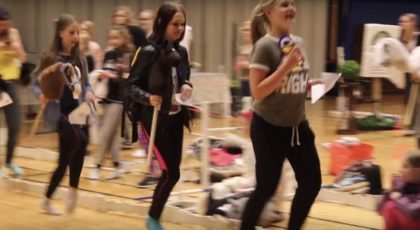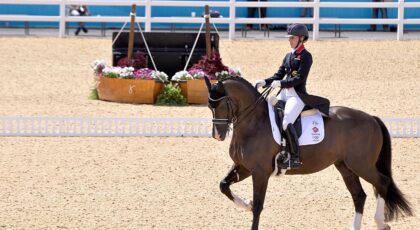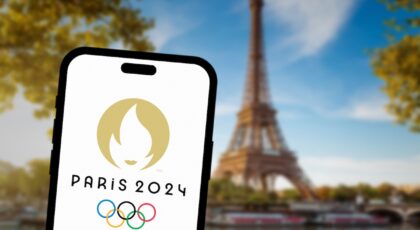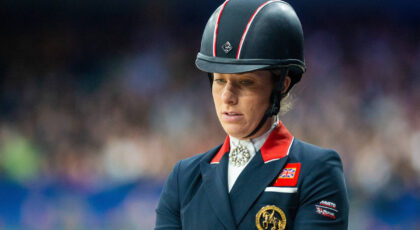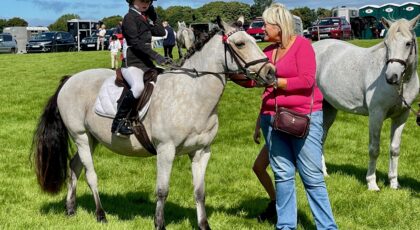Whitney Anderson was born in Alaska into a third-generation commercial fishing family and grew up in Breckenridge, Colorado, and Seattle, Washington. In 2009, she received a B.A. of Fine Arts from Duke University and she hasn’t looked back since, traveling to more than 55 countries, establishing her own fashion label (Big Bold Fierce), and developing a fine-art following for her intricate collage work and thoughtful takes on pop-cultural concepts and design. Through it all, horses have occupied a central place in her heart, both as a personal interest and a muse for her work.
We caught up with Anderson to talk about her process and inspirations, her favorite travels, and that common hazard for collage artists: the awkward gluestick encounter.
There seems to be a variety of subjects that inspire your work, but what is it about horses, in particular?
Horses have long been my favorite animal—I could gaze at their faces all day. I was five years old when I saw Wild Hearts Can’t Be Broken (1991), and Senora and her horse Lightning were the first film heroines I ever knew.
One of my most memorable experiences with horses was a time at camp back when I was 12, after a trail ride with some others. My horse got super excited when he saw that he was back at the farm, and bolted towards the stalls.

(Courtesy of Whitney Anderson)

(Courtesy of Whitney Anderson)
I woke up on the ground, not remembering the incident—my classmates later told me I was thrown—but I did sprain my butt, if that’s possible? I hobbled for a week! Still, I never shied away from my love for these amazing beasts. I find that most things in life that I have yet to figure out are the things that drive me the most, because their mystery lies deeper. Horses are one of those things.
“I work under the nightlight alot because my creativity always blossoms more in the evenings.”
Alright, let’s talk collages—that’s a lot of tiny paper cutouts! What goes into completing something like this?
It takes me roughly 30 hours and there are several parts to my process. I will take old issues of Vogue, Vanity Fair, Glamour, etc., and spend hours flipping through hundreds of pages, cutting out the colors, tones, and textures that pertain to the subject I am creating.
Next, I make my canvas, and then draw the subject and roughly shade in the areas where I will place deeper tones and darker-colored [paper fragments], versus lighter colors in the other areas. The rough drawing takes minutes, buts it’s the hours of gluing and deep focus that come next.

(Courtesy of Whitney Anderson)
Basically, my art piecing sessions can take anywhere from three hours all the way to eight hours in one day. I work under the nightlight a lot, because my creativity always blossoms more in the evenings. I use about seven jumbo glue sticks for these pieces—so every time I go into my local art store to restock, they’re like, “Let me guess, more glue sticks?”

(Courtesy of Whitney Anderson)
After I get done gluing, pasting, and layering (this happens a lot since I don’t always like what I am gluing down, so I just cover it up with new layers until it looks just right), I pour Modge Podge over the entire piece and take a large paint brush to spread it out. It looks like an opaque, milky white, but when it dries it becomes clear again so you can see the collage—thank goodness! The Modge Podge also acts as a sealant.
That’s impressive. And speaking of impressive, 55 countries is a lot of stamps in your passport! What effect did the places you visited have on your art?

Anderson riding in Iceland. (Courtesy of Whitney Anderson)
From the ages of nine to fifteen, my mom took me and my sisters traveling the world, and at almost every country, we went to check out the local riding stables. Two of my favorite memories include galloping in the South of France on indigenous Camargue horses, and visiting The Spanish Riding School in Vienna, Austria. I am grateful to be so enriched by the different cultures of horses I encountered just as much as I was the different cultures of people in the world.
“[Horses] have always been “en vogue” just like fashion. And like fashion, they’ve left their mark on the different realms of history.”
Where do the horse “models” in your work come from?

(Courtesy of Whitney Anderson)

(Courtesy of Whitney Anderson)
I gather them online and seek out images that have the most detail so I can capture their likeness in my large pieces. I do well with more stoic portraits of horses, but I wouldn’t mind doing some more action or candid-type portraits at some point.
The two big themes in your art seem to be horses and high fashion. What is the connection between them, in your mind?
Well, ever since I was young, I have been an avid fashion magazine reader—it is like another art form to me. There is this regal glamour and nostalgia about fashion that is on par with the equestrian world, from Indians riding Appaloosas bareback on the western plains, to superstar racehorses like Seabiscuit and Secretariate at the turn of the century. These animals have always been “en vogue” just like fashion. And, like fashion, they’ve left their mark on the different realms of history. In general, I like to weave different subjects together that I am passionate about.
You also like to include pop art themes in your equestrian portraits…

“Starbucks Native Art on White Ponies”, 2015. (Courtesy of Whitney Anderson)

“Wonder Bred” (Courtesy of Whitney Anderson)
I have incorporated various brands and their themes into my acrylic painting collections, which is one of my main mediums in addition to collage. Two brands, Starbucks and Wonder Bread, have particularly resonated with me.
You also have your own fashion label (Big Bold Fierce). Where do you hope to concentrate your efforts in the coming year?

(Courtesy of Whitney Anderson)
I have always been a fine artist first and foremost, but have channeled my creativity in different ways. I learned a lot about having a [fashion] business these past several years, and I got into many stores and did some tradeshows. It was hard work doing it all on my own, plus having a day job and building up my fine art collection as well.
Although the clothing line has currently taken a back seat to my fine art, it still very much inspires what I do.




 November 9, 2016
November 9, 2016 

















